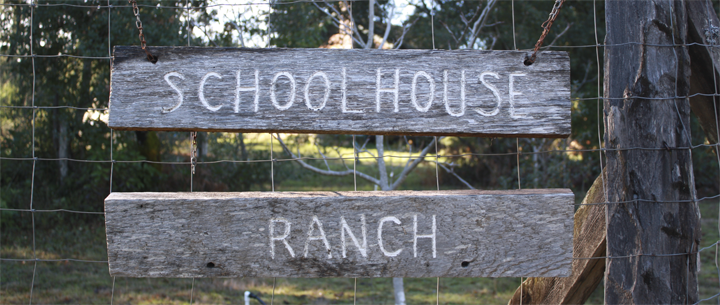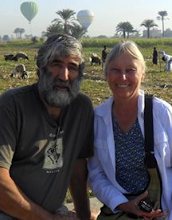We had a 6am wakeup call and a 7:15 bus departure. We stopped along the way to pick up 3 of our group who opted for a hot air balloon ride. At the pickup point there were these huge statues, sort of out in the middle of nowhere, thousands of years old, just looking out over the countryside. There were two of these massive statues, but this one was in the best shape, and it faced a herd of sheep and hot air balloons. Such an odd juxtaposition.
Then on to the
valley of the kings. After we left the tourist entrance center, we were on a road which wound through the desert hills. The tomb entrances have cement bulwarks and a description of who was buried there with highlights of what you'll see. Our ticket entitled us to see 3 tombs and after a brief history lesson, Khalid recommended certain tombs. It was a very hot day, at least 95. We ignored Khalid's advice and chose tombs with short or no lines. We were not disappointed. As we walked down the long corridors leading to antechambers, there were stunning paintings and hieroglyphs on walls and ceilings. Much of the paint is gone, but enough remains to give an idea of how stunning it must once have been. In the tomb of Ramses IV a large chamber had huge ceiling paintings of the goddess of the sky. She is bent into an arch and she is eating the sun at sundown, then stars and night and in the morning she gives birth to it again. At a papyrus factory, we bought a similar small painting.
I seem to have lost all the photos I took inside the tombs, but there are some excellent images
here. In many of the tombs, much of the color remains. The amount of excavation required to make these tombs and the incredible numbers of artists it must have taken to do this work indicates there was a very large population of tomb workers and artisans here. As you leave the valley, you can see many partially excavated worker tombs.
 |
| from tomb of Ramses IV |
 |
| God Re-Horakhty |
|
|
The images above are from this
website which has some more excellent photos from other tombs. I just had to put a few here to encourage you to go look for more. The paintings were gorgeous. Many had been damaged by tomb robbers, but much still remains.
It was sweltering and there are mobs of people and the tombs are nearly as hot or hotter inside as it is outside. I saw the tombs of Setnakht, Siptah from dynasty 19, and Ramses IV. The tomb of Ramses the great is not open and no one knows when it will be. All of the tombs in the valley of the kings had been robbed. When Egypt was strong, there were guards to prevent this, but after Ramses IV, the pharaohs were weak and tombs began to be robbed. After seeing the incredible treasures of
Tutankhamun, the only royal tomb not robbed, it boggles the mind to think of all that was once there.
Still in sweltering heat, we went to
Hatshepsut's Temple. She was one of the few queens to rule Egypt. Our comedian guide said the way to remember her name is Hot Chicken Soup or Hot Cheap Suit. I haven't forgotten it yet. After her death this temple was obliterated by the next pharaoh, a relative who wanted to destroy her. It has been partially restored and sits back into a mountain called Al- Deir Al- Bahari, from which the temple gets it's name. This is where 58 tourists were massacred in 1997, seriously affecting tourism in Egypt for many years. It was all safe today, though, except for the swarms of tourists, most probably unaware of the terrorism attack.


In the heat, we decided to look from afar. It reminded me of greek or roman temples at that distance. By the way, this queen is always shown with a beard, as pharoahs are supposed to have them, so she wore one, like a wig with loops over her ears. She also wore men's clothes, in a successful attempt to have the priests accept her as Pharoah. In the hills surrounding this temple you can see small entrances to what look like caves. They are the tombs of the nobility and the workers. Because these ancient Egyptians believed the afterlife was far better than this life, they spent their lives here on earth getting everything ready for the next. They were mummified so they would have their bodies for their soul to go back to, and the food, servants, jewelry, etc etc. The artisans were well respected and given tombs and probably mummified as payment for their services.
Last but by no means least,
Karnak Temple. Despite the heat, this is not to be missed. This temple was added to by many Pharaohs, including Ramses the great, also known as the Great Eraser. One can see where he added his cartouche, which is a signature, on columns all over the place, and had them carved so deeply that no one could go back and erase them! The columns which line the way in are at least 30 feet tall and supported a roof. In places you can still see the beautiful paintings on remaining roof pieces and here and there on the columns. It must have been incredible to see back then, but of course, a commoner like me wouldn't have been allowed in. Temples were for royalty and priests. The scale of Karnak temple is staggering.
 |
| Ramses Cartouche, deeply incised over other Pharoah's cartouche |

I can't begin to describe what its like to stand in the shadow of these massive columns. It would take 9 people holding hands to encircle one and 100 people standing would fit on top of the column where the ornament is a representation of an open papyrus flower. Then above that would be the massive stone blocks of the roof. In one area of the temple the ramp of earthen bricks still stands to show how they were able to heave massive blocks up that high. At one end of Karnak is a huge crane, ready to help with restoration the modern way. Wilting from the heat, we returned to the ship and lunch and are now cruising on our way to Edfu. Tonight's entertainment is Nubian dancers.





















































